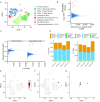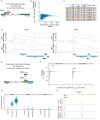Recovery and analysis of transcriptome subsets from pooled single-cell RNA-seq libraries
- PMID: 30496484
- PMCID: PMC6393243
- DOI: 10.1093/nar/gky1204
Recovery and analysis of transcriptome subsets from pooled single-cell RNA-seq libraries
Abstract
Single-cell RNA sequencing (scRNA-seq) methods generate sparse gene expression profiles for thousands of single cells in a single experiment. The information in these profiles is sufficient to classify cell types by distinct expression patterns but the high complexity of scRNA-seq libraries often prevents full characterization of transcriptomes from individual cells. To extract more focused gene expression information from scRNA-seq libraries, we developed a strategy to physically recover the DNA molecules comprising transcriptome subsets, enabling deeper interrogation of the isolated molecules by another round of DNA sequencing. We applied the method in cell-centric and gene-centric modes to isolate cDNA fragments from scRNA-seq libraries. First, we resampled the transcriptomes of rare, single megakaryocytes from a complex mixture of lymphocytes and analyzed them in a second round of DNA sequencing, yielding up to 20-fold greater sequencing depth per cell and increasing the number of genes detected per cell from a median of 1313 to 2002. We similarly isolated mRNAs from targeted T cells to improve the reconstruction of their VDJ-rearranged immune receptor mRNAs. Second, we isolated CD3D mRNA fragments expressed across cells in a scRNA-seq library prepared from a clonal T cell line, increasing the number of cells with detected CD3D expression from 59.7% to 100%. Transcriptome resampling is a general approach to recover targeted gene expression information from single-cell RNA sequencing libraries that enhances the utility of these costly experiments, and may be applicable to the targeted recovery of molecules from other single-cell assays.
© The Author(s) 2018. Published by Oxford University Press on behalf of Nucleic Acids Research.
Figures




Similar articles
-
Single-Cell Transcriptomics of Immune Cells: Cell Isolation and cDNA Library Generation for scRNA-Seq.Methods Mol Biol. 2020;2184:1-18. doi: 10.1007/978-1-0716-0802-9_1. Methods Mol Biol. 2020. PMID: 32808214
-
Data Analysis in Single-Cell Transcriptome Sequencing.Methods Mol Biol. 2018;1754:311-326. doi: 10.1007/978-1-4939-7717-8_18. Methods Mol Biol. 2018. PMID: 29536451
-
Single-Cell Capture, RNA-seq, and Transcriptome Analysis from the Neural Retina.Methods Mol Biol. 2020;2092:159-186. doi: 10.1007/978-1-0716-0175-4_12. Methods Mol Biol. 2020. PMID: 31786788
-
Machine learning and statistical methods for clustering single-cell RNA-sequencing data.Brief Bioinform. 2020 Jul 15;21(4):1209-1223. doi: 10.1093/bib/bbz063. Brief Bioinform. 2020. PMID: 31243426 Review.
-
Current and Future Methods for mRNA Analysis: A Drive Toward Single Molecule Sequencing.Methods Mol Biol. 2018;1783:209-241. doi: 10.1007/978-1-4939-7834-2_11. Methods Mol Biol. 2018. PMID: 29767365 Review.
Cited by
-
Targeted single-cell RNA sequencing of transcription factors enhances the identification of cell types and trajectories.Genome Res. 2021 Jun;31(6):1069-1081. doi: 10.1101/gr.273961.120. Epub 2021 May 19. Genome Res. 2021. PMID: 34011578 Free PMC article.
-
The Analysis of the Human Megakaryocyte and Platelet Coding Transcriptome in Healthy and Diseased Subjects.Int J Mol Sci. 2022 Jul 11;23(14):7647. doi: 10.3390/ijms23147647. Int J Mol Sci. 2022. PMID: 35886993 Free PMC article. Review.
-
Construction of the novel immune risk scoring system related to CD8+ T cells in uterine corpus endometrial carcinoma.Cancer Cell Int. 2023 Jun 22;23(1):124. doi: 10.1186/s12935-023-02966-y. Cancer Cell Int. 2023. PMID: 37349706 Free PMC article.
-
Chikungunya virus infection disrupts lymph node lymphatic endothelial cell composition and function via MARCO.JCI Insight. 2024 Jan 9;9(4):e176537. doi: 10.1172/jci.insight.176537. JCI Insight. 2024. PMID: 38194268 Free PMC article.
-
CD3D Is an Independent Prognostic Factor and Correlates With Immune Infiltration in Gastric Cancer.Front Oncol. 2022 Jun 1;12:913670. doi: 10.3389/fonc.2022.913670. eCollection 2022. Front Oncol. 2022. PMID: 35719985 Free PMC article.
References
-
- Pollen A.A., Nowakowski T.J., Shuga J., Wang X., Leyrat A.A., Lui J.H., Li N., Szpankowski L., Fowler B., Chen P. et al. . Low-coverage single-cell mRNA sequencing reveals cellular heterogeneity and activated signaling pathways in developing cerebral cortex. Nat. Biotechnol. 2014; 32:1053–1058. - PMC - PubMed
Publication types
MeSH terms
Substances
Grants and funding
LinkOut - more resources
Full Text Sources
Other Literature Sources
Molecular Biology Databases

